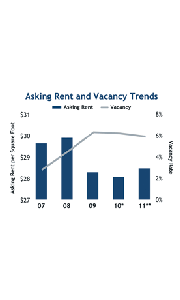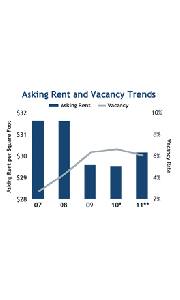Retail Tenants' Market in 2011
2011 might be the year that the retail real estate business catches its breath.
Vacancies were on the rise in 2010, from the most high-profile shopping streets to strip malls hosting discount retailers. The market’s balance of power shifted toward tenants as landlords scrambled to fill buildings.
It will continue to be a tenants’ market in 2011, real estate experts say. Few retail buildings are forecast to be constructed this year, but with the economy gaining strength, formerly vacant commercial space is filling up. However, the recovery won’t help everybody, said Larry Kosmont, president of Los Angeles– based Kosmont Companies, a real estate development services firm.
“You have a bipolar market,” Kosmont said. “It is busy at the top. We’re seeing sales at luxury groups. There is a lot of activity at the value marketplace. What is hurting is the middle.”
Many specialty retailers are consolidating store growth as middle-market consumers remain frugal. Beleaguered mall retailer Pacific Sunwear might close more than 30 stores, said Gary Shoenfeld, PacSun’s chief executive, during a March 15 conference call. However, discount stores and popularly priced fast-fashion stores are actively hunting real estate. Internationally famous designers are choosing Beverly Hills’ Rodeo Drive as the place to debut new boutiques. Tom Ford, Lanvin and Badgley Mischka opened high-profile boutiques on Rodeo recently.
Robertson Boulevard, another highprofile street, might only have one vacancy by April, said Jay Luchs, an executive vice president with CB Richard Ellis. It’s down from a high of seven vacancies last year.
“One year ago, it was borderline problematic,” Luchs said. “It’s done a 180-degree turn.”
The retail real estate market could still be considered problematic for developers. Few construction projects will be completed in Los Angeles County. Square footage of retail real estate will only grow 0.2 percent, according to Marcus & Millichap’s 2011 National Retail Report. It is the lowest level on record, according to the research for the real estate group.
Los Angeles County vacancy is forecast to be 5.9 percent in 2011, according to the Marcus & Millichap report. The vacancy rate in Orange County is forecast to be 6 percent for the upcoming year, according to the report.
The Inland Empire region of Riverside and San Bernardino counties’ vacancy is forecast to be 11.9, according to the report. Limited job creation and hangover from the robust building cycle of the past decade will foster a limited demand for new retail in many areas of the Inland Empire. However, vacancy will remain steady in heavily trafficked shopping areas.
The California towns with the lowest forecasted retail vacancy will be San Francisco and San Diego, with a 3.9 percent and 4.7 percent vacancy rate, respectively. —Andrew Asch























